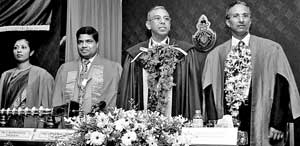
Facing the challenges in combating STDMale and female problem clinics to tackle recurrences in genital diseases, dedicated clinics for sex workers and the introduction of emergency contraceptive services and sexual dysfunction services were the sweeping changes called for by Dr. G. Weerasinghe, President of the College of Venereologists of Sri Lanka recently.“In keeping with the new requirements, challenges and changes in our speciality, I propose these new services within the clinics for sexually transmitted diseases,” he said at the inaugural ceremony of the 12th annual academic sessions of the college held from November 1 – 3. We will not be able to escape from the need to provide these services, which should start sooner than later, in the best interests of the control and prevention of sexually transmitted diseases and HIV/AIDS in Sri Lanka, he explained. Pointing out that it was in 1952 that the Anti Venereal Disease Campaign was launched in the country, Dr. Weerasinghe queried whether 55 years later, the National STD/AIDS Control Programme (NSACP) adequately reflects the real scope of the speciality, since venereology covers many conditions that may not have been transmitted exclusively through sex.
Looking afresh at some common conditions that result in repeated attendance at STD clinics, he stressed that Non-Gonococcal Urethritis, Genital Herpes, Pelvic Inflammatory Disease, Bacterial Vaginosis and Vulvovaginal Candidiasis (VVC) or thrush are both inconvenient to the patient and costly for the service provider.“That is why I would like to propose that we set up special male and female problem clinics conducted by senior registrars and/or consultants in the speciality to deal with these patients. This is likely to renew confidence in treatment among patients, provide relief and reduce costs of care,” he said. Dealing with HIV, Dr. Weerasinghe was of the opinion that since HIV and AIDS is not only a health problem, their control and prevention is not and should not be the responsibility of the NSACP alone. The availability of antiretroviral therapy (ART), free of charge since December 2004 is a major step in the battle against HIV, according to him, but requests for ART to be provided in all districts appear to be oversimplifying ART management. These requests indicate a sheer lack of understanding of the gravity of the issue. Addressing some major aspects that need to be considered before starting ART, he said the preparation of a patient for ART, the choosing of the best regimen for the patient, the necessity of regular monitoring once ART has commenced, the assuring adherence to the regimen – a life long process and the stopping or/and switching when indicated were vital. “At the end of September 2007, there were 102 patients on ART, ,” said Dr. Weerasinghe. Considering the numbers and geographical distribution of known HIV patients and available expertise to manage ART, the NSACP is providing those services to the best of its ability. However there is no doubt in the years to come the NSACP will be able to provide ART in all provinces when the newly qualified venereologists assume duties. Going into data, he said the total number of visits recorded by STD clinics in 2004, 2005 and 2006 were 77,609, 73,089 and 81,349 respectively. There have been 10,153 new episodes of sexually transmitted infections diagnosed in 2005 and 10,268 in 2006 throughout the country. “We are aware that the patients seen in the STD clinics reflect only the tip of the iceberg. The annual estimates of new episodes of STIs are around 60,000 to 200,000. These figures are a clear indication of the extent of risky behaviour that people engage in.”
On the other hand, the data on STI also indicate the vulnerability of Sri Lanka to an explosion of the HIV epidemic. That is why the control and prevention of STDs is being regarded as a fundamental strategy for control and prevention of HIV all over the world, he said. Explaining the groups who are vulnerable, Dr. Weerasinghe said that when we think of people who seek STD services, sex workers naturally come to mind. Epidemiologically, sex workers are considered as the source and reservoir of STD/HIV/AIDS in all countries and considered one of the groups most vulnerable to infection. Thousands of visits by sex workers have been recorded in STD clinics and this is probably the tip of the iceberg and the majority is unlikely to be benefiting by services that STD clinics can offer. The External Review of the national response to sexually transmitted infections and HIV/AIDS in Sri Lanka in 2006, identified strategic priorities for the NSACP. These included the need to map sex workers and develop an essential service package including clinical services for STIs and promotion of condom use. These have now been incorporated in the National Strategic Plan 2007 – 2011 and are expected to increase the accessibility of STD services for sex workers. How are we to achieve the target set in the National Strategic Plan, he asks and answers that a viable option would be to establish dedicated clinics for sex workers starting at the Central STD Clinic in Colombo. As a provider of sexual health services, we also need to address the issue of contraception, including emergency contraception available at STD clinics. Available data indicates that about 150,000 to 175,000 induced abortions take place annually in this country and about 10% of these are among unmarried women. Abortion is not legalized in Sri Lanka and may be performed only on medical concurrence to save the life of the mother, he said. Only simple arithmetic is needed to work out the enormous costs of induced abortions if one costs Rs. 3,000. The cost, however, escalates dramatically when complications occur and the loss of life that may take place cannot be costed, he said. “When we consider the possible health consequences, these women may be potentially vulnerable to STDs as well as HIV infection. We should be able to attract these women to our services by offering them emergency contraceptive services and at the same time STD care under one roof as in many other countries,” explains Dr. Weerasinghe. Another area that is important but rarely addressed is that of sexual dysfunctions. It is a matter of concern that these services are still not formalized within our state services, he says, adding that few men and women pass through life without experiencing some concerns and difficulties with their sexual life. The confidential atmosphere in an STD clinic would be appropriate and comfortable for people with sexual dysfunctions to seek relief. |
|| Front
Page | News | Editorial | Columns | Sports | Plus | Financial
Times | International | Mirror | TV
Times | Funday
Times || |
| |
Reproduction of articles permitted when used without any alterations to contents and the source. |
© Copyright
2007 | Wijeya
Newspapers Ltd.Colombo. Sri Lanka. All Rights Reserved. |

